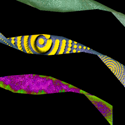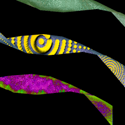Twist or twirl
Many biomolecules such as nucleic acids, proteins, and lipids exhibit chirality that depends on how the molecules form, or self-assemble, into different shapes.
As their name suggests, chiral amphiphiles are molecules that are found in both aqueous and fatty environments. They self-assemble into myriad shapes, ranging from dotlike micelles to tubular micelles to two-dimensional sheets.
In a paper in Physical Review Letters, Lior Ziserman at the Technion-Israel Institute of Technology and colleagues, also in Israel, study a class of ribbon-forming chiral amphiphiles. With their cryogenic transmission electron microscopy imaging the authors capture a dynamic transition along a single ribbon that changes shape from twisted (negative Gaussian curvature) to spiral (zero Gaussian curvature). Quantitative analysis shows that the width of the ribbon determines the nature of this morphology. While the result is not unexpected—Monte Carlo simulations in 2004 predicted how curvature in certain molecules would depend on their physical properties, and subsequent analytic theory has predicted that change would behave as a phase transition—this is a useful experimental confirmation of a morphological change determined by ribbon width in such pervasive biological structures. – Sami Mitra





